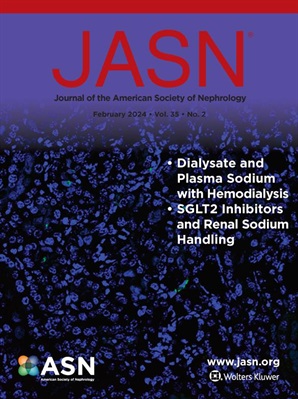Identification of Epigenetic Regulators of Vascular Calcification with a CRISPR-Based Screen.
IF 9.4
1区 医学
Q1 UROLOGY & NEPHROLOGY
引用次数: 0
Abstract
BACKGROUND Vascular calcification, mainly driven by osteogenic transdifferentiation of vascular smooth muscle cells (VSMCs), is a common pathological condition in patients with chronic kidney disease. However, the roles of other epigenetic regulators in this process remain largely unexplored. CRISPR screen is a highly efficient strategy widely used in identifying genes related to various biological processes. However, the lack of suitable cell sorting strategies combined with CRISPR screen meant this technology had not been applied to gene screening in vascular calcification. METHODS We performed an epigenetic-focused CRISPR screen in primary human VSMCs and identified key genes and pathways underlying osteogenic transdifferentiation, based on sgRNA enrichment in RANKL + (calcified) and RANKL - (noncalcified) VSMCs isolated by magnetic activated cell sorting. To validate the screen results, potential genes with different rankings were validated by siRNA intervention and Alizarin Red S staining. Integrating CRISPR results with transcriptome data revealed 17 critical regulators. We further investigated the top hit, Anthrax Toxin Receptor 1 (ANTXR1), in vascular calcification by examining clinical human samples and intervention in mice model. RESULTS Through CRISPR screen, we identified 122 potential genes positive-regulating vascular calcification and 116 negative-regulating genes. Phenotypic experimental results further verified the roles of genes with different rankings in osteogenic transdifferentiation of VSMCs, reinforcing the validity of our CRISPR screen system. Notably, integrative analysis of CRISPR screen with transcriptome data revealed ANTXR1 as a critical factor regulating vascular calcification. Furthermore, detection of clinical human samples confirmed the upregulation of ANTXR1 during calcification. Knockdown of ANTXR1 suppressed vascular calcification in mice model; likewise, overexpression promoted vascular calcification and the osteogenic transdifferentiation of VSMCs. CONCLUSIONS Our epigenetic-focused CRISPR screen and transcriptome analysis identified critical epigenetic genes involved in vascular calcification.基于crispr筛选血管钙化的表观遗传调控因子。
背景:血管钙化主要由血管平滑肌细胞(VSMCs)的成骨转分化驱动,是慢性肾脏疾病患者常见的病理状况。然而,其他表观遗传调节因子在这一过程中的作用仍未被充分探索。CRISPR筛选是一种高效的策略,广泛用于识别与各种生物过程相关的基因。然而,缺乏合适的结合CRISPR筛选的细胞分选策略意味着该技术尚未应用于血管钙化的基因筛选。方法我们在原代人VSMCs中进行了以表观遗传学为重点的CRISPR筛选,并基于磁性激活细胞分选分离的RANKL +(钙化)和RANKL -(非钙化)VSMCs中sgRNA的富集,确定了成骨转分化的关键基因和途径。为了验证筛选结果,通过siRNA干预和茜素红S染色对不同排序的潜在基因进行验证。将CRISPR结果与转录组数据相结合,揭示了17个关键调控因子。我们通过对临床人体样本和小鼠模型的干预进一步研究了炭疽毒素受体1 (ANTXR1)在血管钙化中的作用。结果通过CRISPR筛选,鉴定出122个血管钙化正调控基因和116个血管钙化负调控基因。表型实验结果进一步验证了不同排序基因在VSMCs成骨转分化中的作用,强化了我们CRISPR筛选系统的有效性。值得注意的是,CRISPR筛选与转录组数据的整合分析显示ANTXR1是调节血管钙化的关键因子。此外,对临床人类样本的检测证实了钙化过程中ANTXR1的上调。敲低ANTXR1抑制小鼠血管钙化同样,过表达促进血管钙化和VSMCs的成骨转分化。结论通过以表观遗传为重点的CRISPR筛选和转录组分析,确定了参与血管钙化的关键表观遗传基因。
本文章由计算机程序翻译,如有差异,请以英文原文为准。
求助全文
约1分钟内获得全文
求助全文
来源期刊
CiteScore
22.40
自引率
2.90%
发文量
492
审稿时长
3-8 weeks
期刊介绍:
The Journal of the American Society of Nephrology (JASN) stands as the preeminent kidney journal globally, offering an exceptional synthesis of cutting-edge basic research, clinical epidemiology, meta-analysis, and relevant editorial content. Representing a comprehensive resource, JASN encompasses clinical research, editorials distilling key findings, perspectives, and timely reviews.
Editorials are skillfully crafted to elucidate the essential insights of the parent article, while JASN actively encourages the submission of Letters to the Editor discussing recently published articles. The reviews featured in JASN are consistently erudite and comprehensive, providing thorough coverage of respective fields. Since its inception in July 1990, JASN has been a monthly publication.
JASN publishes original research reports and editorial content across a spectrum of basic and clinical science relevant to the broad discipline of nephrology. Topics covered include renal cell biology, developmental biology of the kidney, genetics of kidney disease, cell and transport physiology, hemodynamics and vascular regulation, mechanisms of blood pressure regulation, renal immunology, kidney pathology, pathophysiology of kidney diseases, nephrolithiasis, clinical nephrology (including dialysis and transplantation), and hypertension. Furthermore, articles addressing healthcare policy and care delivery issues relevant to nephrology are warmly welcomed.

 求助内容:
求助内容: 应助结果提醒方式:
应助结果提醒方式:


